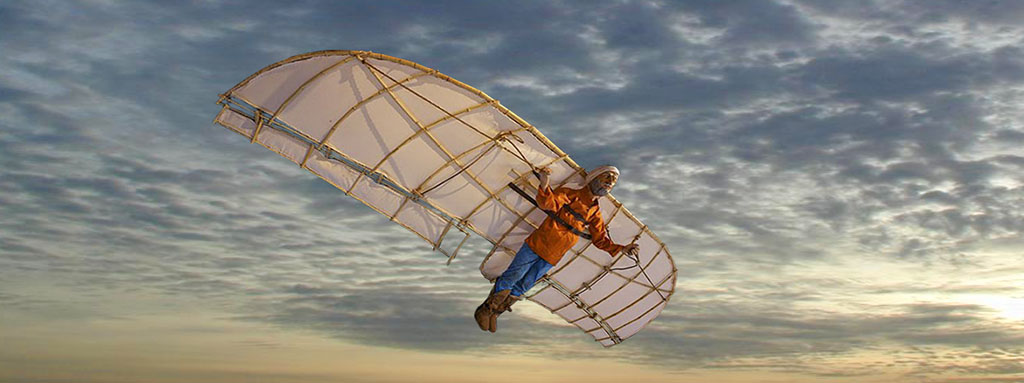Throughout the history of mankind, there have been memorable people whose contribution to science can be considered exceptional. We know the names of many of them, and in the context of aeronautics, the following illustrious names immediately come to mind: da Vinci, Cayley, Montgolfier, Le Bris, Lilienthal, Ader, Pilcher, Whitehead, Zeppelin, Torres y Quevedo, Santos-Dumont, Wright, Alcock, Forlanini, de la Cierva, Lindbergh, Latécoère and a few dozen more. There are other names which, however, have passed quietly into oblivion, despite the fact that their contribution has been truly remarkable. Such is the case of the scientist, historian, poet, inventor and, of course, aviation pioneer, Abbas Ibn Firnas.
Some pioneers are forgotten by history, and such is the case of Abbas Ibn Firnas, the first man to fly on a heavier-than-air machine and lived to tell the tale.
Many are surprised to learn that this man was the first to fly with a heavier-than-air machine, staying in flight for about ten seconds. And he did this more than a thousand years before the Wright brothers, specifically in the year 875. So who was Abbas Ibn Firnas?
He was born Abu al-Qāsim Abbās ibn Firnās and came into the world in the year 810, not far from the city of Ronda (in the province of Malaga, Spain). Relatively little is known about his childhood, except that he acquired an extensive education and came to the fore in various disciplines, which led him inexorably to the city of Cordoba, which at that time was the richest and most influential in Al-Andalus. There he stood out as a scientist, inventor, poet, philosopher, alchemist, musician and astrologer, to such an extent that he became known as Hakim Al-Andalus (the Wiseman of Al-Andalus).
Once in Cordoba, he went on to develop those facets of his knowledge that significantly contributed to the advancement of the sciences and the arts in the courts of the emirs al-Hakam (796-822), Abderramán II (822-852) and Muhammad I (852-886).
In the scientific field, he was the first in the Iberian Peninsula, and probably in Europe, to use the Sindhind astronomical tables, of Indian origin, which later would prove fundamental to the development of European science and would be studied in medieval universities as a Quadrivium subject (integrating the study of music, arithmetic, geometry and astronomy).
He introduced the Western world to the technique for carving rock crystal and even developed alchemical procedures to create crystals from different minerals.
He built an anaphoric clock, a complex mechanism that uses water as a liquid engine (energy). The water flow is closed or opened by a series of valves and the clock serves to show the hour at any time of the day or night, something which was unusual at the time.
He also developed the first armillary sphere (or spherical astrolabe) in Europe, used to perform calculations and approximate astronomical observations, by moving the instrument’s rings according to the plane of the celestial rings.
As an example of his advanced knowledge of astronomy, he built a mechanically articulated planetarium at his residence in Cordoba which represented the celestial vault. He even provided it with sound and visual effects that simulated various weather phenomena: storms, lightning and thunder.
In the context of aerospace, Abbas Ibn Firnas is an extraordinary reference point as the creator of the precursor to the parachute and for being the first person to successfully design, build and test artefacts that remained in flight. He did this six hundred years before Leonardo da Vinci developed his designs for flying machines, and more than a thousand years before the Wright brothers made their famous flight.
His first aeronautical milestone was achieved in the year 852, when he jumped into the void from the tower of Cordoba’s Mosque, using canvas as an innovative parachute. Nothing like it had ever been attempted before. Or at least, nobody had lived to tell the tale until then. The result was a relatively rapid descent involving a rough landing and several broken bones, but it led to a firm conviction that the method could work. This event is widely considered as the first use of a parachute in history.
Years later, in 875, he designed a glider made of wood and silk (decorated with feathers from several different birds), and he launched himself with it from the La Arruzafa hills, near Cordoba. He was so sure that his invention would work that he had convened hundreds of people to watch along the route. Also present were many members of the court of Muhammad I, Emir of the Andalusi caliphate. The result was a sustained flight using air currents, which lasted anything between two and ten minutes (depending on the historical accounts used as reference). Despite a difficult landing, he not only survived but also became the first man to fly with a heavier-than-air machine.
Even using the most pessimistic figures for his flight, it was much longer in both time and distance to that achieved in 1903 by the Wright brothers.
The name of Abbas Ibn Firnas currently figures in the names of airports, bridges, hills, parks, avenues and scientific bodies, especially in countries with a Berber (Imazighen) background, but what will no doubt ensure his immortality is that one of the craters of the moon has also been named after him.



